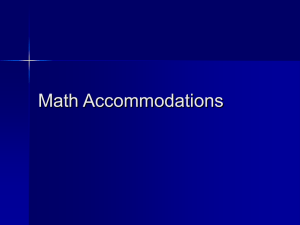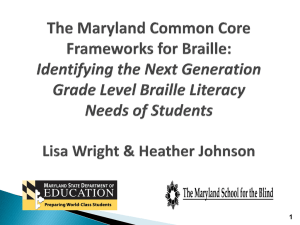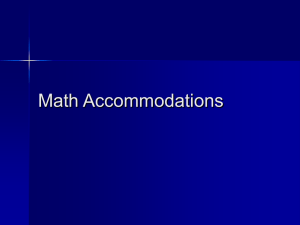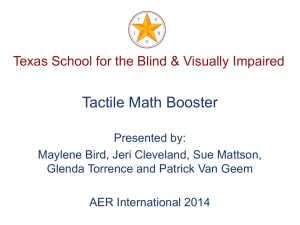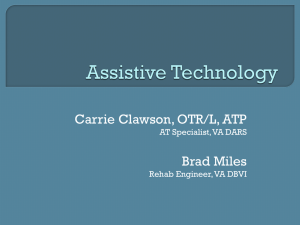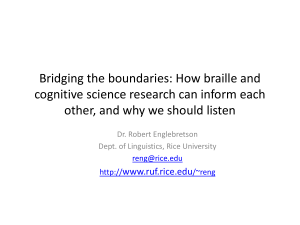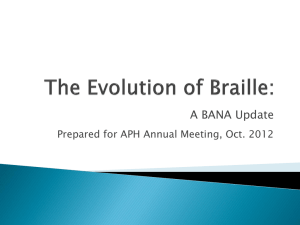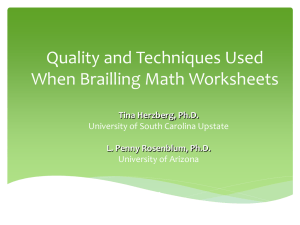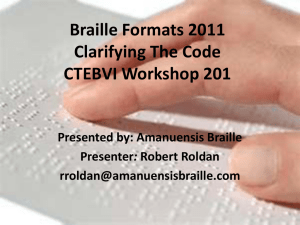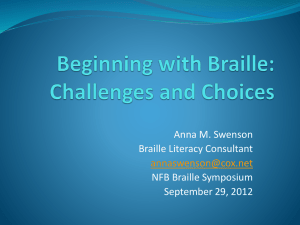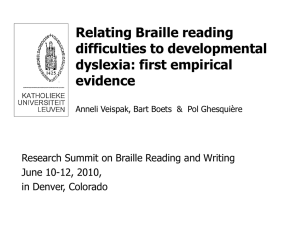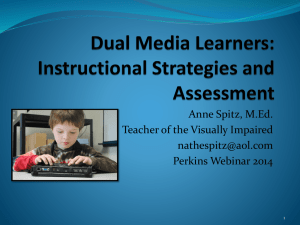On the Road to Developing Nemeth Braille Code Competencies for
advertisement
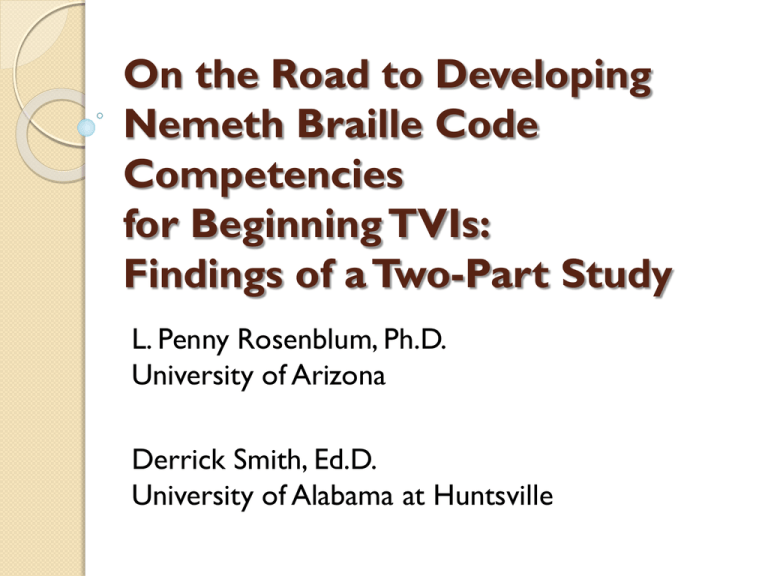
On the Road to Developing Nemeth Braille Code Competencies for Beginning TVIs: Findings of a Two-Part Study L. Penny Rosenblum, Ph.D. University of Arizona Derrick Smith, Ed.D. University of Alabama at Huntsville Development of Literary Braille Competencies AER Personnel Preparation Division formed a group to investigate the development of standards for literary braille. Sandy Lewis, Frances Mary D’Andrea and L. Penny Rosenblum conducted a Delphi Study (JVIB, 2012). Next logical step was to conduct a Delphi Study to investigate the development of standards for Nemeth code. Paul Ajuwon Sheila Amato Donna Brostek Lee Tina Herzberg Sunggye Hong Cheryl Kamei-Hannan Beth Harris Patricia Myers L. Penny Rosenblum Derrick Smith Sandy Smith Adam Wilton Kim Zebehazy Nemeth Delphi Committee Members Committee Procedure Questionnaire developed to collect demographic data A list of Nemeth code skills was developed A list of skills in other codes (foreign language, music, computer), abacus, and tactile graphics was developed Purpose of the Demographic Study To gather information on how university programs prepare future teachers of students with visual impairments in the areas of the Nemeth braille, foreign language braille, computer braille, music braille codes, the abacus, and tactile graphics. Study Procedure 39-item questionnaire using online survey software Open to university programs in the United States and Canada for six weeks in fall 2011 22 individuals representing 26 universities participated Delivery of Course Content Face-to Face On-Line Hybrid Literary Braille 7 7 11 Nemeth Braille 7 9 9 Foreign Language Braille 8 8 6 Music Braille 6 7 6 Computer Braille 8 6 7 Abacus 7 9 8 Tactile Graphics 7 5 13 Content How Content is Delivered Content Primary Embedded Correspond N/A Literary Braille 25 1 0 0 Nemeth Braille 24 1 1 0 Foreign Language Braille 3 18 0 5 Music Braille 2 16 1 7 Computer Braille Abacus 3 18 0 5 10 13 3 0 Tactile Graphics 4 21 0 1 Tools Used to Produce Braille Perkins S&S Literary Braille 26 26 22 16 14 Nemeth Braille 26 1 18 4 4 Foreign Language Braille 14 0 8 1 1 Music Braille 9 0 9 0 0 Computer Braille 10 0 11 4 4 Abacus -- -- -- -- -- Tactile Graphics -- -- -- -- -- Content Brl Em. Brl.Tran. Elec. All University Programs Required Students to Demonstrate Mastery Numerals Numeral indicator Punctuation indicator English letter indicator Fraction indicator Fractions Operations Comparison Decimals Problems in Linear Format Most University Programs Required Students to Demonstrate Skills Mastery Basic Knowledge None Problems in Spatial Format 25 1 -- Level Indicator 25 1 -- Groupings 25 1 -- Radical Indicator 21 5 -- Multipurpose Indicator 21 5 -- Radicals 10 5 1 Skill Algebra and Geometry Had More Variability Mastery Basic Knowledge None Absolute Value 17 7 2 Shapes 17 9 -- Arrows 15 11 -- Angles 15 11 -- Lines 12 13 1 Arcs 9 10 7 Skill Advanced Math Had Even More Variability Mastery Basic Knowledge None Functions 8 12 6 Logarithms 4 9 13 Advanced Math 6 13 7 Matrices 2 10 14 Skill Nemeth Resources Resource Required Rec. Shown No Unsure An Introduction to Braille Mathematics 14 3 3 5 2 The Nemeth Braille Code for Mathematics and Science Notation 9 12 3 1 1 Mathematics Made Easy for Children with Visual Impairment 2 2 1 20 3 Braille Codes and Calculations 5 2 6 11 3 Nemeth Resources Required Recom. Shown No Unsure Learning Nemeth Braille Code 13 4 3 6 0 Strategies for Developing Mathematics Skills in Students Who Use Braille 7 4 8 6 1 Chapter on Nemeth code in New Programmed Instruction in Braille 11 3 1 10 2 Braille Code of Chemical Notation 1 0 8 16 1 Resource Resources Shared with Students TSBVI web site (n=10) APH web site and/or reference sheet (n=9) National Braille Press web site or books (n=5) BANA web site or books (n=5) Project Math Access web site or materials (n=4) How Students Demonstrate Competence Homework or weekly tests (n=23) Final exam (n=18) Midterm exam (n=5) Less frequently mentioned: ◦ Lesson plans ◦ Postings on discussion boards ◦ Adapting materials Procedures 13 programs allowed students to resubmit homework. 7 programs did not allow students to resubmit homework. 1 program required students to write out what rules were not followed. Few programs allowed students to remediate final or midterm exams. Foreign Language Braille Code Foreign language braille was at the exposure level. Few programs required a homework assignment. BANA web site was shared as a resource. Foreign Language, Computer and Tactile Graphics Resources Content Interim Manual for Foreign Language The Computer Braille Code Made Easy Computer Braille Code Tactile Graphics Required Recom. Shown No Unsure 1 4 5 14 1 1 1 8 12 1 6 6 6 7 1 0 4 10 11 1 Computer Braille Code Almost all programs gave a brief introduction to computer braille code. 2 programs indicated that computer braille code was integrated into an assistive technology course. Music Braille Code Dancing Dots and Library of Congress were web sites shared with students. Few programs required students to complete a braille music homework. Music Resources Content Who is Afraid of Braille Music How to Read Braille Music Music Braille Code Required Recom. Shown No Unsure 1 1 5 16 3 0 2 10 11 3 3 7 8 9 2 Abacus Five programs required students to complete an abacus course from Hadley School for the Blind. Thirteen programs had students on an exam compute using an abacus. Three programs had students do homework assignments with an abacus. Three programs had students teach a child to compute with an abacus. Eight programs allowed students to redo abacus assignments and ten did not. Abacus Resources Resource Use of the Cranmer Abacus The Abacus Made Easy Abacus Basic Competency: A Counting Method Required Recom. Shown No Unsure 10 2 8 4 3 5 3 10 7 3 3 2 11 8 3 Tactile Graphics Five programs shared BANA guidelines. Ten programs shared APH guidelines and materials (e.g., Draftsman, models). Nineteen programs had specific assignments and activities. Twenty-three programs required students to prepare tactile graphics. Three programs had exam questions about tactile graphics. Rosenblum, L. P. & Smith, D. (2012). Instruction in Specialized Braille Codes, Abacus, and Tactile Graphics at Universities in the United States and Canada. Journal of Visual Impairment & Blindness, 106(6), 339-350. NEMETH DELPHI Development of the Delphi Instrument 13-member focus group developed 29 statements that could be competencies. Panelists rated each statement for reading and writing. For each statement panelists rated the level of importance and the type of references to be used (none, code reference, book). Agreement level was set at 85%. Criteria to Join the Nemeth Delphi Panel In the last three years taught at least one course on how to read and write Nemeth code Taught the Nemeth code for at least three semesters / quarters Taught the Nemeth code for at least three or more years Taught in the United States or Canada Taught skills for students to read and write Nemeth code Read/Write in Context Linear Problems Reading ◦ Importance: Extremely Important (100%, n = 20) ◦ References: No References (94%, n = 17) Writing ◦ Importance: Extremely Important (95%, n = 19) ◦ References: No References (94%, n = 17) Read/Write Punctuation Signs, Symbols used in Nemeth Reading ◦ Importance: Extremely Important (100%, n = 20) ◦ References: No References (94%, n = 17) Writing ◦ Importance: Extremely Important (100%, n = 20) ◦ References: No Agreement Read/Write Simple Fractions/Mixed Numbers Reading ◦ Importance: Extremely Important (100%, n = 20) ◦ References: No References (94%, n = 19) Writing ◦ Importance: Extremely Important (100%, n = 20) ◦ References: No Agreement Read/Write Computation in Spatial Format Reading ◦ Importance: Extremely Important (100%, n = 20) ◦ References: No References (94%, n = 17) Writing ◦ Importance: Extremely Important (100%, n = 20) ◦ References: No References (94%, n = 17) Read/Write Expressions w/Grouping Symbols, Including Parentheses Reading ◦ Importance: Extremely Important (100%, n = 20) ◦ References: No References (94%, n = 17) Writing ◦ Importance: Extremely Important (95%, n = 19) ◦ References: No Agreement Read/Write Expressions w/Decimals, Percentages, Negative Numbers Reading ◦ Importance: Extremely Important (85%, n = 17) ◦ References: No References (94%, n = 16) Writing ◦ Importance: Extremely Important (100%, n = 20) ◦ References: No Agreement Read/Write Expressions w/More Advanced Signs of Comparison Reading ◦ Importance: Extremely Important (94%, n = 17) ◦ References: Code Reference (89%, n = 16) Writing ◦ Importance: No Agreement ◦ References: Code Reference (94%, n = 17) Read/Write Expressions with Superscripts Reading ◦ Importance: Extremely Important (94%, n = 16) ◦ References: Code Reference (89%, n = 16) Writing ◦ Importance: Extremely Important (85%, n = 17) ◦ References: No Agreement Read/Write Expressions with Subscripts Reading ◦ Importance: Extremely Important (89%, n = 16) ◦ References: No Agreement Writing ◦ Importance: No Agreement ◦ References: No Agreement Read/Write Expressions with Radicals Reading ◦ Importance: Extremely Important (94%, n = 17) ◦ References: Code Reference (89%, n = 16) Writing ◦ Importance: No Agreement ◦ References: No Agreement Read/Write Expressions with Complex Numbers Reading ◦ Importance: No Agreement ◦ References: No Agreement Writing ◦ Importance: No Agreement ◦ References: Reference Book (89%, n = 16) Read/Write Letters Representing Measurement Units Reading ◦ Importance: Extremely Important (94%, n = 17) ◦ References: No References (89%, n = 16) Writing ◦ Importance: Extremely Important (94%, n = 16) ◦ References: Code Reference (89%, n = 16) Read/Write Nemeth Code Signs of Comparison Reading ◦ Importance: Extremely Important (89%, n = 16) ◦ References: Code Reference (89%, n = 16) Writing ◦ Importance: No Agreement ◦ References: Code Reference (89%, n = 16) Read/Write Nemeth Code Signs for Rates and Derived Measurements Reading ◦ Importance: Extremely Important (89%, n = 16) ◦ References: No Agreement Writing ◦ Importance: No Agreement ◦ References: No Agreement Read/Write Formulae for Area/Volume of Geometric Figures Reading ◦ Importance: No Agreement ◦ References: No Agreement Writing ◦ Importance: No Agreement ◦ References: Reference Book (90%, n = 18) Read/Write Letters Used to Symbolize Variables Reading ◦ Importance: Extremely Important (94%, n = 17) ◦ References: No References (94%, n = 17) Writing ◦ Importance: Extremely Important (94%, n = 17) ◦ References: No Agreement Read/Write Algebraic Equations w/Polynomials, Rational Numbers Reading ◦ Importance: Extremely Important (89%, n = 16) ◦ References: Code Reference (89%, n = 16) Writing ◦ Importance: Extremely Important (89%, n = 16) ◦ References: No Agreement Read/Write Algebraic Equations w/Logarithmic Numbers Reading ◦ Importance: No Agreement ◦ References: Reference Book (94%, n = 17) Writing ◦ Importance: No Agreement ◦ References: Reference Book (95%, n = 18) Read/Write Algebraic Equations using Periodic Functions Reading ◦ Importance: No Agreement ◦ References: Reference Book (94%, n = 17) Writing ◦ Importance: No Agreement ◦ References: Reference Book (85%, n = 17) Read/Write Algebraic Equations using Inequalities Reading ◦ Importance: Extremely Important (89%, n = 16) ◦ References: Code Reference (89%, n = 16) Writing ◦ Importance: No Agreement ◦ References: No Agreement Read/Write Statements Using Shape Indicators Reading ◦ Importance: Extremely Important (94%, n = 17) ◦ References: No Agreement Writing ◦ Importance: Extremely Important (94%, n = 17) ◦ References: Reference Book (89%, n = 16) Read/Write Compass Directions Using Arrow Indicators Reading ◦ Importance: No Agreement ◦ References: Reference Book (89%, n = 16) Writing ◦ Importance: Somewhat Important (89%, n = 16) ◦ References: Reference Book (85%, n = 17) Read/Write Symbols for Congruence, Similar, Parallel, Perpendicular Reading ◦ Importance: Important (89%, n = 16) ◦ References: No Agreement Writing ◦ Importance: No Agreement ◦ References: Reference Book (89%, n = 16) Read/Write Coordinate Indicators Reading ◦ Importance: Extremely Important (89%, n = 16) ◦ References: No References (94%, n = 17) Writing ◦ Importance: No Agreement ◦ References: No Agreement Read/Write Indicators for Angles, Lengths, Arcs, Perimeters, Areas,Volume Reading ◦ Importance: No Agreement ◦ References: Reference Book (94%, n = 17) Writing ◦ Importance: No Agreement ◦ References: Reference Book (85%, n = 17) Read/Write Trigonometric Indicators for Length and Angle Measurements Reading ◦ Importance: No Agreement ◦ References: Reference Book (95%, n = 18) Writing ◦ Importance: No Agreement ◦ References: Reference Book (94%, n = 17) Read/Write Cartesian Coordinates, Navigational, Polar, Spherical Reading ◦ Importance: No Agreement ◦ References: Reference Book (89%, n = 17) Writing ◦ Importance: No Agreement ◦ References: Reference Book (95%, n = 19) Read/Write Indicators for Plane,Vectors, Function Notation, Matrices Reading ◦ Importance: No Agreement ◦ References: Reference Book (95%, n = 18) Writing ◦ Importance: No Agreement ◦ References: Reference Book (100%, n = 20) Read/Write Various Indicators/Equations for Statistical Data Reading ◦ Importance: No Agreement ◦ References: Reference Book (95%, n = 18) Writing ◦ Importance: No Agreement ◦ References: Reference Book (100%, n = 19) Final Thoughts University programs place a greater emphasis on literary & Nemeth braille codes than other braille codes. There is variability in the competencies students must demonstrate in Nemeth code when it comes to more advanced (middle school and up) math. Abacus computation is taught at most universities though the level of proficiency students must demonstrate varies. Final Thoughts The Delphi panel agreed on the following: ◦ The level of importance for 20 reading statements ◦ The level of importance for 12 writing statements ◦ The level of references for 22 reading statements ◦ The level of importance for 17 writing statements What’s Next? Publication of a second article in JVIB in 2013 (Smith & Rosenblum) Possible follow-up study to find out more about what students at various age levels are reading and writing in Nemeth code Discussion with the Personnel Preparation Division about the adoption of Nemeth code competencies by university programs
